Fenix Tsense OLED Handleiding
Fenix
Thermostaat
Tsense OLED
Bekijk gratis de handleiding van Fenix Tsense OLED (12 pagina’s), behorend tot de categorie Thermostaat. Deze gids werd als nuttig beoordeeld door 54 mensen en kreeg gemiddeld 3.5 sterren uit 27.5 reviews. Heb je een vraag over Fenix Tsense OLED of wil je andere gebruikers van dit product iets vragen? Stel een vraag
Pagina 1/12

A.
B.
LOCK
Tsense OLED Bluetooth Thermostat 230V 16A IP21
www.taelek.fi/documents
VIDEOS AND
MANUALS
App Store, Google Play and Homey
are trademarks of Apple, Google and
Athom, in respectively.
EN DE CZ SK FR PL ES RU
N873/R00 (14.01.22)

EN
Tsense OLED Thermostat
Installation and User Manual
The best possible EU ecodesign 2009/125/EC rating (40%).
EU2015/1188 Information requirements for electric local space heaters:
With electronic room temperature control plus day timer YES
With distance control option YES
With adaptive start control YES
With open window detection YES
TECHNICAL SPECIFICATIONS
Bluetooth: Version 4.2
Power supply: 230V - 50Hz
Maximum load: 16A (resistive)
Temperature range: +5°C/+35°C
External Temperature setback: 230V - 50Hz
IP class: IP21
Standard Color: White, Black
Sensors: Built-in room sensor and external floor
sensor NTC or wireless BLE sensor
INSTALLATION
Installation must be done by a qualified electrician in accordance with wiring and building
regulations. Before installation, disconnect any power to the thermostat’s mains.
In a factory new thermostat the front cover (A) and frame (B) are loose and you can just
pull them out. If the visual parts are fixed then push the rotary dial (C°) hard downwards
and while holding it down turn anti-clockwise. The front cover and the frame can now be
pulled away easily.
Connect the wires to the thermostat’s terminal: SETBACK: External Setback Wire (if
applicable), Heating Cable N connection, Power N connection, HEATING (N): N: FLOOR
SENSOR: HEATING (L): L: Floor temp sensor NTC, Heating Cable L connection, Power L
connection.
Next, position the thermostat and fasten it into the wall mounting box using 2-4 screws.
Assemble the frame. Check that fixing nails are in 'LOCK' position. If not use screwdriver
to push them to correct position. Push the front cover until it snaps in place. The front
cover should now be firmly fixed on all sides.
STARTUP
After connecting the power to the thermostat for the first time thermostat recognizes if
floor sensor is connected or not and makes initialization accordingly (selects between
floor mode and air mode). The following settings are initialized accordingly (floor/air).
Name of thermostat : RANDOM number
Mode : Floor / Air
Floor temperature min : 5°C / NaN
Floor temperature max : 27°C / NaN
Floor temperature offset (calibration) : -3°C
Air temperature min : 5°C
Air temperature max : 28°C
Air temperature offset (calibration) : 0°C
PWM min – PWM max : 0% - 100%
Snow melting ON temperature min : 0°C
Snow melting ON temperature max : 10°C
Snow melting OFF temperature: -25°C
Snow melting air humidity min: 30%
User program activated eco temp : 19°C
Externally activated eco temp : 19°C
Valve protection : OFF
Sensor type : 10k ohm
Display brightness in standby: 70%
Weekly program : OFF
Use ecoControl App to check and modify settings.
BASIC USE
The thermostat is controlled by rotary dial (C°) and a touch button (SET). The basic use of
thermostat is described in picture END USER FUNCTIONS:
1. Normal mode with dim screen saver display. Use rotary dial to step into active mode
(2).
2. Active mode. Rotating the dial takes you to modify the set temperature of a current
operating state (3). Touching the set button enters the menu (4).
3. Adjust the temperature set value of the current state (comfort, eco or externally
activated setback eco). Return to the start by touching the set button or automatically
after a timeout period.
Notice that in set value page current operating state is shown under the set temperature
digits. A flash symbol is indicating the relay activity.
4. In menu you can step from function to function with the rotary dial and then enter the
function by touching the set button:
- touch the set button to select comfort state and adjust the temperature set value with
rotary dial. Return back to start by touching the set button.
- select eco mode by touching the set button and adjust with rotary dial the set point of
user program eco temperature or the setback eco temperature (if setback input active).
Return to the start by touching the set button.
- display the current heating mode
- select BOOST 1h to force a thermostat to use a special temperature for 1 hour
- switch off the power by touching the set button. Power is switched on by rotating the
dial.
- display the link to user manuals (QR-code link)
- from EXIT you return to the start by touching the set button.
ADVANCED USE
You can access all the thermostat data with a free of charge ecoControl App running in
Android and iOS mobile devices. With the App you read logged temperatures, modify
settings and define a weekly user program. App can also generate email reports. Follow
the guides in ecoControl App. Thermostat indicates the mobile device connection with
fast blinking red led.
1. Settings
Thermostat has several settings which can easily be adjusted with ecoControl App. Note!
Remember to save changes before leaving the setting page.
Name of thermostat
A free and descriptive name shown in ecoControl App
Heating mode
Thermostat can measure and adjust floor air temperature, temperature, air temperature
with floor limits ( ), heating ratio ( control) or it can melt snow and ice from dual PWM
outdoor stairs and driveways in mode. snow melting
Floor temperature min and max
This setting has two main purposes. In floor mode min and max values specify active
range of knob. In dual mode this setting does not effect the knob but thermostat keeps
floor temperature between limits. Feature can be used to protect wooden floors (max
limit) or e.g. to guarantee warm floor in room with fireplace. Note: N/A in PWM and in
air mode.
Floor temperature offset (calibration)
If user's temperature measurement has offset to knob setpoint this setting is used to
calibrate. Note, floor sensor inside floor construction is much warmer than real
temperatures measured in room. Thus default is -3C to have rotary knob adjustment
range in realistic area of 18C...24C.
Air temperature min and max
This setting has two main purposes. In air and dual mode it specifies active knob range.
In all other modes it can be used as air over temperature protection.
Air temperature offset (calibration)
If user's temperature measurement has offset to knob setpoint this setting is used to
calibrate.
PWM min and max
This setting has two main purposes. In PWM mode min and max values specify active
knob range. In all other modes it guarantees maximum pulse ratio. Note: Setting can be
used, e.g., to limit maximum heating power to comply with installation standard
EN50599. Cycle time of PWM is 10 minutes.
Snow melting ON temperature min and max
Min and max setting specify the active knob range. When outdoor temperature is below
this setting point the snow melting operation is active.
Snow melting OFF temperature
When it is colder than this temperature the snow melting is switched OFF.
Snow melting air humidity min
When wireless outdoor temperature sensor is used the thermostat also receives air
humidity level. Snow melting function will not be activated if the air humidity is below
this limit.
User program activated eco temp
During all green hours in user program the temperature is adjusted to this value. In PWM
mode, the pulse ratio in eco mode is half of the pulse ratio in comfort mode. In snow
melting, eco mode switches off the heating completely.
Externally activated eco temp
When 230VAC (pilot signal) is connected to the setback input terminal the temperature
set value is defined by this parameter.
Valve protection
Valve protection turns heating ON once per week for 5 minutes even at summer time.
This setting is typically used with water carrier floor heating valves. Feature prevents the
valve from getting stuck during summer.
Sensor type
Floor sensors from different manufacturers can be used. Supported types are 2k, 10k,
12.5k, 15k, 33k NTCs.
Display brightness
Brightness of the Oled display in standby mode.
User program mode
AUTO enables the user program, OFF disables it.
Wireless temperature sensor
Adding a wireless BLE temperature sensor allows the best location for temperature
measurement. It is also very accurate. To add a wireless sensor you have to select it in
the ecoControl App and enter the sensor address in Network key fields.
Receive wireless eco controls
A thermostat with an external setback switch can control several other thermostats to go
in setback mode. This feature will save the user from hard wiring the Home/Away switch
to many thermostats. To form a group of thermostats you need to enable the Receive
wireless eco controls Network key and write a freely selectable group name in fields.
Network key and Confirm Network key
Network key is used to identify the wireless temperature sensor or the group of
thermostats to receive the wireless eco controls. Both fields need to have exactly the
same text string and you have to save the settings. For the wireless sensor you can use
the QR code (back side of the device or inside of the cover part). Just use the camera
function in App (bottom of the screen) to read the code, then accept and save it.
Lock function
The thermostat display can be locked and unlocked with the app. Use PIN code 0914.

2. Week schedule
User can create 24h/7d week schedule in ecoControl App. With week schedule the user
programs thermostat to decrease temperature during time slots when room is not used.
Comfort/eco state is indicated with red/green led.
Week schedule execution needs correct real time in thermostat. In case of invalid real
time the week program is deactivated and user is warned with an error message on
screen. Real time is updated from ecoControl App every time the thermostat is connected
to a mobile device. Real time clock can manage power breaks of up to 2 hours.
3. Error modes
Thermostat indicates an erratic state by displaying the text ERROR and the error code.
The most typical case is that real time is corrupted during too long power break. This is
automatically solved by taking connection with ecoControl app. Possible error codes are:
1 Floor sensor fault Heating OFF
2 Over heat Heating OFF
3 Internal fault Heating OFF
10 Calendar time is not valid User program OFF
You may try to reset the fault by switching off the power to soft reset or by using
ecoControl App to generate a hard reset. In errors 1, 2, 3 heating is permanently off. In
error 10 user program is deactivated.
WARRANTY AND LIABILITY:
Seller warrants that this product is free from defects in manufacturing, materials and
workmanship for a period of two years. The liability of seller is limited to deliver a new
thermostat per faulty one according to warranty statement above. Seller has right to
receive faulty units to be checked. Seller's liability explicitly excludes everything
exceeding above conditions.
DE
Tsense OLED Thermostat
Installations- und Benutzerhandbuch
Die bestmögliche EU Eco-Design 2009/125/EC Bewertung (40%).
EU2015/1188 Informationsanforderungen für elektrische Einzelraumheizgeräte:
Mit elektronischer Raumtemperaturkontrolle und Wochentagsregelung JA
Mit Fernbedienungsoption JA
Mit adaptiver Regelung des Heizbeginns JA
Mit Erkennung offener Fenster JA
TECHNISCHE DATEN
Bluetooth: Version 4.2
Stromversorgung: 230 V 50 Hz
Maximale Last: 16 A (resistiv)
Temperaturbereich: +5 °C/+35 °C
Externe Temperaturabsenkung: 230 V 50 Hz
IP-Klasse: IP21
Standardfarbe: Weiß, Schwarz
Sensoren: Eingebauter Raumsensor und externer
Bodensensor NTC oder drahtloser BLE-
Sensor.
INSTALLATION
Die Installation muss durch einen qualifizierten Elektriker gemäß den Verkabelungs- und
Bauvorschriften erfolgen. Trennen Sie vor der Installation alle Netzanschlüsse des
Thermostats.
Bei einem fabrikneuen Thermostat sind die Frontabdeckung (A) und der Rahmen (B) lose
und können einfach herausgezogen werden. Wenn die Sichtteile fixiert sind, drücken Sie
den Drehknopf (C°) fest nach unten und drehen Sie ihn in gedrückter Position, während
Sie ihn gegen den Uhrzeigersinn drehen. Jetzt können die Frontabdeckung und der
Rahmen leicht abgezogen werden.
Schließen Sie die Drähte an die Klemmen des Thermostats an: Externe RÜCKSETZUNG:
Rücksetzungsleitung (falls zutreffend), : Anschluss Heizkabel N, HEIZUNG (N) N:
Stromanschluss N, : Temperatursensor NTC, Anschluss BODENSENSOR HEIZUNG (L):
Heizkabel L, Stromanschluss L. L:
Positionieren Sie als nächstes den Thermostat und befestigen Sie ihn mittels 2 - 4
Schrauben an der Wandeinbaudose. Montieren Sie den Rahmen. Achten Sie darauf, dass
sich die Befestigungsnägeln in der Position „LOCK“ befinden. Falls nicht, verwenden Sie
einen Schraubendreher, um sie in die korrekte Position zu drücken. Drücken Sie die
Frontabdeckung auf ihren Platz, bis sie einrastet. Die Frontabdeckung sollte jetzt auf allen
Seiten fest angebracht sein.
ANLAUFEN
Nach dem erstmaligen Anschließen des Stroms an den Thermostat erkennt der
Thermostat, ob der Bodensensor angeschlossen ist oder nicht und nimmt entsprechend
die Initialisierung vor (Auswahl zwischen Bodenmodus und Luftmodus). Die folgenden
Einstellungen werden dementsprechend initialisiert (Boden/Luft).
Bezeichnung des Thermostats: ZUFALLSNUMMER
Modus: Boden/Luft
Bodentemperatur min.: 5 °C / NaN
Bodentemperatur max.: 27°C / NaN
Bodentemperaturrücksetzung (Kalibrierung): -3°C
Lufttemperatur min.: 5°C
Lufttemperatur max.: 28°C
Lufttemperaturrücksetzung (Kalibrierung): 0°C
PWM min. - PWM max. : 0 % - 100%
Abschmelzen von Schnee EIN Temperatur-Min.: 0°C
Abschmelzen von Schnee EIN Temperatur-Max.: 10°C
Abschmelzen von Schnee AUS Temperatur: -25°C
Abschmelzen von Schnee Luftfeuchtigkeit Min.: 30%
Durch Anwenderprogramm aktivierte Eco-Temp.: 19 °C
Extern aktivierte Eco-Temp.: 19 °C
Ventilschutz: AUS
Sensortyp: 10 kOhm
Display-Helligkeit im Bereitschaftsmodus: 70%
Wöchentliches Programm: AUS
Nutzen Sie die ecoControl-App, um die Einstellungen zu überprüfen und zu ändern.
GRUNDLEGENDE VERWENDUNG
Das Thermostat wird über einen Drehknopf (C°) und eine Touch-Taste (SET) gesteuert.
Die grundlegende Verwendung des Thermostats ist im Bild ENDBENUTZERFUNKTIONEN
beschrieben:
1. Normaler Modus mit abgedunkelter Bildschirmschoneranzeige. Verwenden Sie das
Drehrad, um in den aktiven Modus zu wechseln (2).
2. Aktiver Modus. Durch Drehen des Drehknopfes kann die Solltemperatur eines
aktuellen Betriebszustandes verändert werden (3). Durch Antippen der Set-Taste gelangt
man in das Menü (4).
3. Passen Sie den Temperatursollwert des aktuellen Zustands an (Komfort, Eco oder
extern aktivierter Absenk-Eco). Rückkehr zum Start durch Berühren der Set-Taste oder
automatisch nach einer festgelegten Zeit.
Beachten Sie, dass auf der Sollwertseite der aktuelle Betriebszustand unter den Ziffern
der Solltemperatur angezeigt wird. Ein Blinksymbol zeigt die Relaisaktivität an.
4. Im Menü können Sie mit dem Drehrad von Funktion zu Funktion springen und dann die
Funktion durch Berühren der Set-Taste eingeben:
- Berühren Sie die Set-Taste, um den Komfortzustand auszuwählen, und stellen Sie den
Temperatursollwert mit dem Drehknopf ein. Kehren Sie zum Start zurück, indem Sie die
Set-Taste berühren.
- Eco-Modus durch Berühren der Set-Taste auswählen und mit dem Drehknopf den
Sollwert des Benutzerprogramms Eco-Temperatur oder die Rücksetz-Eco-Temperatur
(wenn Rücksetzeingang aktiv) einstellen. Kehren Sie zum Anfang zurück, indem Sie die
Set-Taste berühren.
- Anzeige des aktuellen Heizmodus
- Wählen Sie BOOST 1h, um einen Thermostat zu zwingen, 1 Stunde lang eine bestimmte
Temperatur zu verwenden.
- Schalten Sie die Stromversorgung durch Berühren der Set-Taste aus. Das Einschalten
erfolgt durch Drehen des Drehknopfes.
- Link zu Benutzerhandbüchern anzeigen (QR-Code-Link).
- Von EXIT kehren Sie durch Berühren der Set-Taste zum Start zurück.
ERWEITERTE VERWENDUNG
Mit der kostenlosen ecoControl App, die auf Android- und iOS-Mobilgeräten läuft,
können Sie auf alle Thermostatdaten zugreifen. Mit der App lesen Sie protokollierte
Temperaturen aus, ändern Einstellungen und definieren ein wöchentliches
Benutzerprogramm. Die App kann außerdem E-Mail-Berichte generieren. Befolgen Sie die
Anleitungen in der ecoControl-App. Ein Thermostat zeigt die Verbindung zu einem
Mobilgerät durch eine schnell blinkende rote LED an.
1 Einstellungen
Der Thermostat verfügt über mehrere Einstellungen, die durch die ecoControl-App
angepasst werden können. Hinweis! Bitte speichern Sie Änderungen immer, bevor Sie
die Einstellungsseite wieder verlassen.
Name des Thermostats
Ein freier und beschreibender Name, der in der ecoControl App angezeigt wird.
Heizmodus
Das Thermostat kann temperatur, temperatur, Lufttemperatur mit Boden Luft-
Bodengrenzen ( ), Heizverhältnis ( -Steuerung) messen und anpassen oder im dual PWM
Schneeschmelzmodus Schnee und Eis von Treppen und Einfahrten schmelzen.
Bodentemperatur min. und max.
Diese Einstellung hat zwei Hauptzwecke. Die Min.- und Max.-Werte im Bodenmodus
geben den aktiven Bereich des Drehschalters an. Im dualen Modus beeinflusst diese
Einstellung nicht den Drehschalter, aber der Thermostat hält die Bodentemperatur
zwischen den Grenzwerten. Die Funktion kann genutzt werden, um die Holzfußböden zu
schützen (max. Grenzwert) oder um einen warmen Boden in einem Raum mit Kamin zu
gewährleisten, z. B. Hinweis: Hinweis: Gilt nicht im PWM- und Luftmodus.
Bodentemperaturabsenkung (Kalibrierung)
Wurde die Temperaturmessung des Anwenders auf den gewählten Sollwert abgesenkt,
wird diese Einstellung für die Kalibrierung genutzt. Hinweis, der Bodensensor innerhalb
der Fußbodenkonstruktion ist viel wärmer als die real im Raum gemessenen
Temperaturen. Daher ist der Standardwert -3 °C, um einen Einstellbereich des
Drehschalters in einem realistischen Bereich von 18 - 24 °C zu haben.
Lufttemperatur min. und max.
Diese Einstellung hat zwei Hauptzwecke. Dies gibt den aktiven Wählbereich im Luft- und
Dualmodus an. In allen anderen Modi kann dies als Frost-/Übertemperaturschutz
verwendet werden.
Lufttemperaturabsenkung (Kalibrierung)
Wurde die Temperaturmessung des Anwenders auf den gewählten Sollwert abgesenkt,
wird diese Einstellung für die Kalibrierung genutzt.
PWM min. und max.
Diese Einstellung hat zwei Hauptzwecke. Die Min.- und Max.-Werte im PWM-Modus
geben den aktiven Bereich des Drehschalters an. In allen anderen Modi gewährleistet dies
ein maximales Impulsverhältnis. Hinweis: Die Einstellung kann verwendet werden, um z.
B. die maximale Heizleistung zu begrenzen und damit die Einbaunorm EN50599
einzuhalten. Die Zykluszeit von PWM beträgt 10 Minuten.
Schneeschmelze EIN Temperatur min und max
Product specificaties
| Merk: | Fenix |
| Categorie: | Thermostaat |
| Model: | Tsense OLED |
Heb je hulp nodig?
Als je hulp nodig hebt met Fenix Tsense OLED stel dan hieronder een vraag en andere gebruikers zullen je antwoorden
Handleiding Thermostaat Fenix

23 December 2023

23 December 2023
Handleiding Thermostaat
- Levica
- Elektrobock
- Fibaro
- Bulex
- Truma
- Extraflame
- Hager
- Tylö
- Radson
- Emerson
- Braeburn
- Tellur
- Landis Gyr
- ACV
- Busch-Jaeger
Nieuwste handleidingen voor Thermostaat
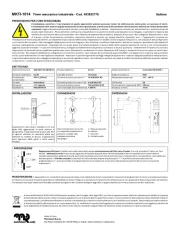
2 September 2025
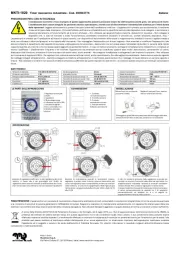
1 September 2025
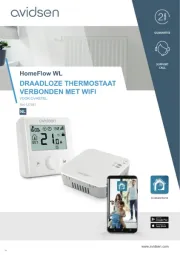
30 Augustus 2025
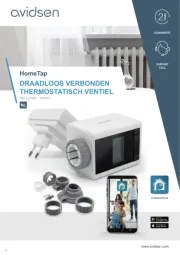
30 Augustus 2025
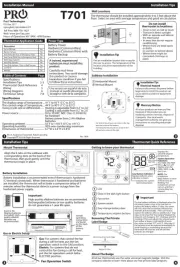
26 Augustus 2025
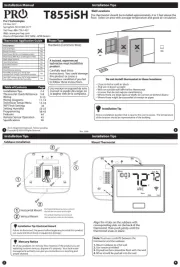
26 Augustus 2025
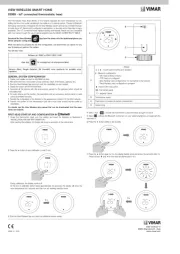
26 Augustus 2025
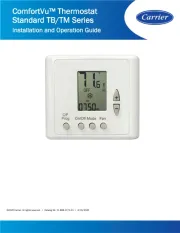
26 Augustus 2025
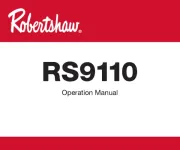
26 Augustus 2025
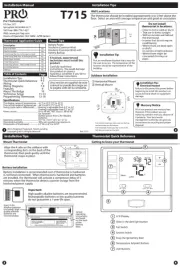
26 Augustus 2025